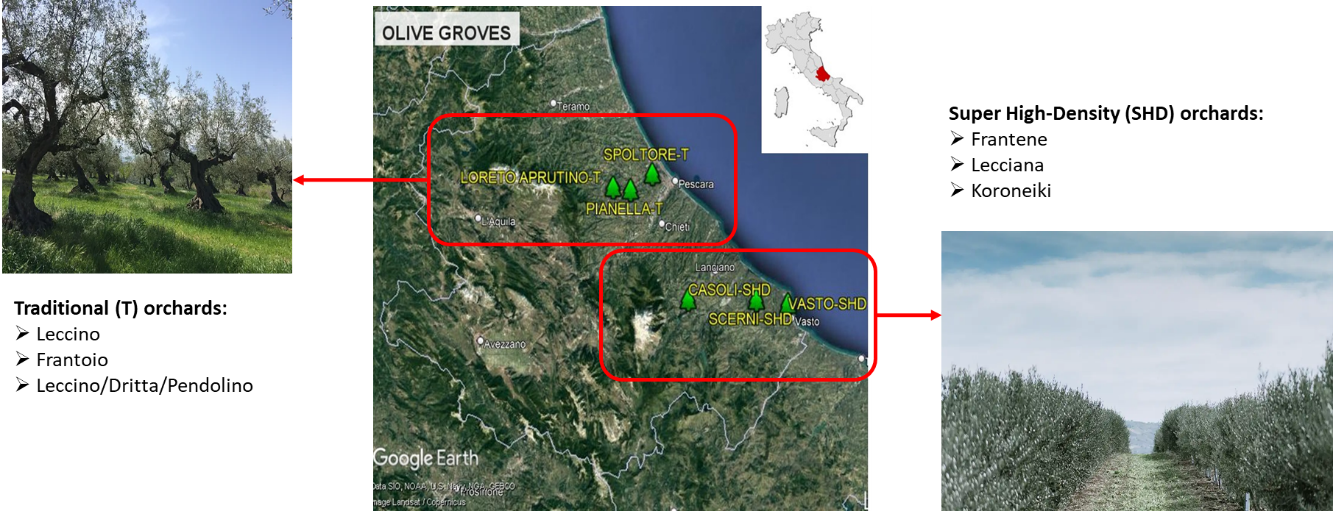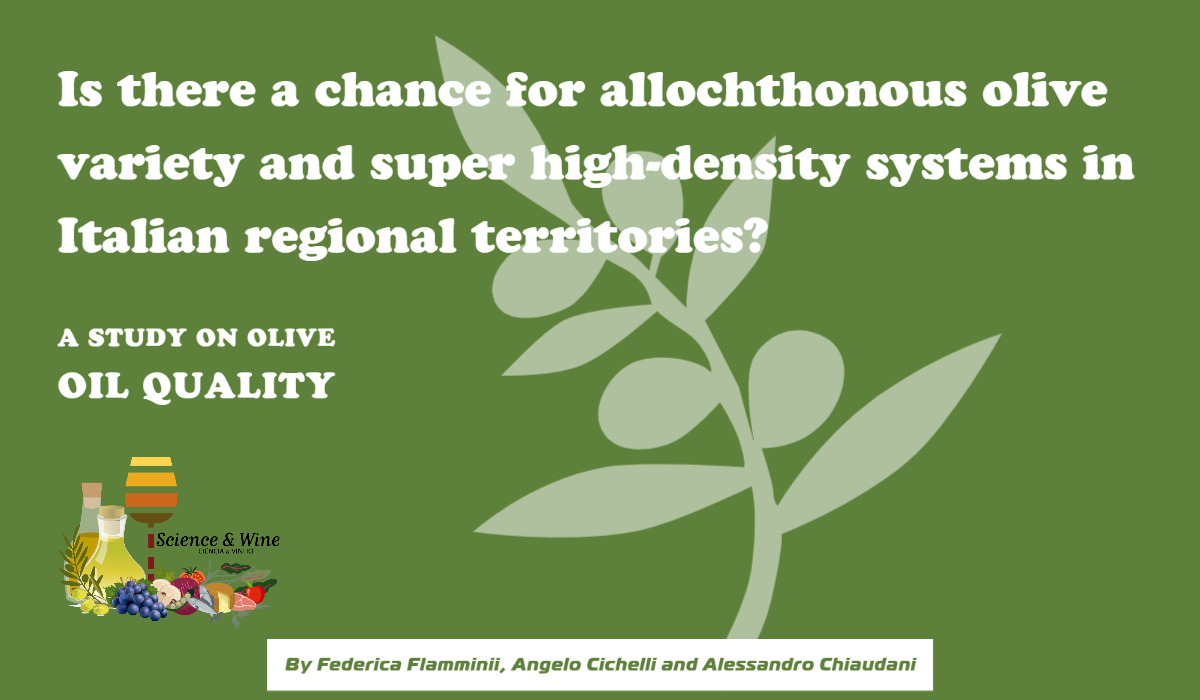By Federica Flamminii, Angelo Cichelli and Alessandro Chiaudani
Department of Innovative Technologies in Medicine and Dentistry, University “G. d’Annunzio” of Chieti-Pescara, Via dei Vestini, 66100, Chieti Scalo, (CH), Italy;
federica.flamminii@unich.it
The transition to a sustainable economic and environmental management of the olive oil sector needs to be implemented in both Italian national and regional territories through the introduction and development of innovative growing systems and variety. The olive-oil sector represents a fundamental pillar in the economy and landscape for both Italy and Abruzzo region, located in the center of the peninsula. The Italian olive oil sector is characterized by limited cultivated areas, different farming systems, extreme fragmentation of the production structures and a vast national olive germplasm that in-creases the variability of the final product [1]. These general national aspects reflect the regional situation and represent the main drawback for the development of the olive sector. Furthermore, the scarce income generated does not allow farmers to introduce all the innovations necessary to be competitive on the international market with other more productive regions and nations.
In the Abruzzo region (Italy), the maximum olive cultivation and production is concentrated along the coastal hill, however olive trees are widely distributed overall the regional territory, starting from the sea to the foothills of Majella and Gran Sasso at 600-700 meters above sea level thanks to local varieties that are particularly suitable for these environments [2]. Although it is highlighted a good quality of the regional production, confirmed by few scientific researches regarding autochthonous olive cultivars of Abruzzo region [3–4], no significant economies are realized due to the presence of technical-structural, organizational and commercial issues along the entire supply chain. Furthermore, most olive orchards are exploited under traditional plantation systems, characterized by a reduced number of trees per hectare, rainfed and poorly mechanized.
The introduction of structural innovation, technology and techniques, through the adoption of intensive planting scheme with high-density (HD; 250-700 trees ha-1) and super high-density (SHD; 1,500 trees ha-1) systems, could represent an important strategy for the overall olive oil sector, leading to increasing yields production, earlier bearing, efficient harvesting, higher financial return, reduced production costs.
This new cultivation strategy has driven a revolution in olive oil production throughout the introduction of olive cultivars particularly designated for HD and SHD systems that can overcome difficulties in production; several trials evaluated the behavior of autochthonous cultivars with high planting densities from around 800 to almost 2,600 trees ha−1, comparing with Arbequina, Arbosana, Koroneiki and Sikitita that are considered the most common intensively planted varieties around the world [5-7]. It is important to underling that despite growing system intensification increases agrochemicals use, irrigation and mechanization, with a consequent greater environmental impact [1], the super-intensive olive groves could be renamed super-sustainable olive groves since has been observed that it reduce the olive carbon [8] and water footprint (WF) as well [8,9]; consequently these innovative growing techniques should be considered as a powerful marketing tool for olive oil companies to orient the decision making of consumers increasingly attentive to social-environmental and food quality issues [1].
Based on this preface, is there a chance for allochthonous olive variety and super high-density systems in Italian regional territories? Useful to answer this question is a research related the olive oil quality parameters of allochthonous olive cultivars grown in super high-density orchards and traditionally trained varieties, cultivated in Abruzzo region (Italy). The olive oils, derived from allochthonous cultivars such as Lecciana, Frantene, Koroneiki, were compared with the oils extracted from autochthonous cultivar as Frantoio, Leccino, Dritta (Figure 1).

Figure 1. Location of traditional and super high-density orchards of autochthonous and allochthonous olive variety.
The results of the study highlighted the good performances of the allochthonous olive cultivars Koroneiki, Arbequina, Frantene and Lecciana cultivated in super high-density orchards. In particular, the related olive oils resulted rich of flavonoids such as diosmetin, luteolin and apigening and secoiridoids, such as oleacein and oleocanthal, with high nutraceutical properties, indeed, it is well known that the latest possesses intense anti-inflammatory effects comparable to ibuprofen [10] and it is also responsible for the burning pungent sensation of virgin olive oil [11]. Regarding the fatty acid profile, important for the technological and nutritional quality of the oils, Frantene showed a peculiar pattern, rich in both monounsaturated (MUFA) and polyunsaturated (PUFA) fatty acids, and also different from the other allochthonous cultivars grown in the same conditions such as Lecciana, Koroneiki and Arbequina.
What is interesting was the similarity of oils derived from the mix of local variety Leccino/Dritta and Frantene (Figure 2), in terms of health-related properties such as, polyphenols, tocopherols, antioxidant activity and oleic/linoleic ratio, confirming that, despite the variability of pedoclimatic and agronomic conditions, characteristic of the Abruzzo territory, as well as the cultivar, it is possible to obtain high quality olive oils produced with foreign variety comparable to those obtained with the traditional ones.

Figure 2. Heat map with the four main functional parameters used to cluster the oil samples
The answer to the initial question is therefore, yes. The results of the study identify olive varieties suitable for super high-density systems cultivated in Abruzzo region and represent a valid alternative for the olive growers to improve both the quality of the olive oil, as well as the company’s income, in regional as well as in national area.
Read more in: https://doi.org/10.3390/foods12061292

Federica Flamminii is a researcher at the University “G. D’Annunzio” of Chieti (Italy) in the food technology field. She works on the valorization of agro-industrial by-products, mainly the vegetable ones, by means the extraction of bioactive compounds (polyphenols, tocopherols, proteins, …) and their use as functional ingredients in food formulations. Federica obtained a PhD in Food Science at the University of Teramo (Italy). Extraction, stabilization by encapsulation technology, food applications and related chemical and technological characterization of foodstuffs are her area of expertise. Federica also focuses her research on the characterization and valorization of extra virgin olive oils of the Abruzzo region obtained from autochthonous olive cultivars.
References
- Lombardo, L.; Farolfi, C.; Tombesi, S.; Novelli, E.; Capri, E. Development of a sustainability technical guide for the Italian olive oil supply chain. Sci Total Environ. 2022, 820, 153332. https://doi.org/10.1016/J.SCITOTENV.2022.153332
- Flamminii, F.; Marone, E.; Neri, L.; Pollastri, L.; Cichelli, A.; Di Mattia, C.D. The Effect of Harvesting Time on Olive Fruits and Oils Quality Parameters of Tortiglione and Dritta Olive Cultivars. Eur J Lipid Sci Technol. 2021, 123,. https://doi.org/10.1002/ejlt.202000382
- Di Serio, M.G.; Giansante, L.; Del Re, P.; Pollastri, L.; Panni, F.; Valli, E.; Di Giacinto, L. Characterization of ‘Olivastro di Bucchianico cv’ extra virgin olive oils and its recognition by HS-GC-IMS. J Sci Food Agric. 2021, 101, 6074–6082. https://doi.org/10.1002/jsfa.11264
- Sabetta, W.; Mascio, I.; Squeo, G.; Gadaleta, S.; Flamminii, F.; Conte, P.; Daniela, C.; Mattia, D.; Piga, A.; Caponio, F.; Montemurro, C. Bioactive Potential of Minor Italian Olive Genotypes from Apulia, Sardinia and Abruzzo. Foods. 2021, 10, 1371. https://doi.org/10.3390/foods10061371
- Farinelli, D.; Tombesi, S. Performance and oil quality of ‘Arbequina’ and four Italian olive cultivars under super high density hedgerow planting system cultivated in central Italy. Sci Hortic (Amsterdam). 2015, 192, 97–107. https://doi.org/10.1016/J.SCIENTA.2015.04.035
- Tombesi, A.; Proietti, P.; Iacovelli, G.; Tombesi, S.; Farinelli, D. Vegetative and productive behaviour of four olive Italian cultivars and “Arbequina” according to super intensive olive training system in central Italy. Acta Hortic. 2011, 924, 211–218. https://doi.org/10.17660/ACTAHORTIC.2011.924.26
- Tombesi, S.; Tombesi, A.; Molfese, M.; Cipolletti, M.; Visco, T. Evaluation of four cultivars regarding their suitability in high-intensity olive orchards. Acta Hortic. 2011, 924, 321–326. https://doi.org/10.17660/ACTAHORTIC.2011.924.40
- Pattara, C.; Russo, C.; Antrodicchia, V.; Cichelli, A. Carbon footprint as an instrument for enhancing food quality: overview of the wine, olive oil and cereals sectors. J Sci Food Agric. 2017, 97, 396–410. https://doi.org/10.1002/JSFA.7911
- Camposeo, S.; Vivaldi, G.A.; Russo, G.; Melucci, F.M. Intensification in Olive Growing Reduces Global Warming Potential under Both Integrated and Organic Farming. Sustainability. 2022, 14, 6389. https://doi.org/10.3390/SU14116389
- Beauchamp, G.; Keast, R.; Morel, D.; Lin, J.; Pika, J. Ibuprofen-like activity in extra-virgin olive oil. Nature. 2005, 437, 45–46
- Andrewes, P.; Busch, J.L.H.C.; De Joode, T.; Groenewegen, A.; Alexandre, H. Sensory properties of virgin olive oil polyphenols: Identification of deacetoxy-ligstroside aglycon as a key contributor to pungency. J Agric Food Chem. 2003, 51, 1415–1420. https://doi.org/10.1021/JF026042J/ASSET/IMAGES/LARGE/JF026042JF00004.JPEG

